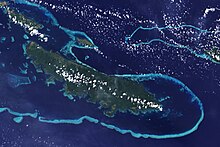Our website is made possible by displaying online advertisements to our visitors.
Please consider supporting us by disabling your ad blocker.
Reef




A reef is a ridge or shoal of rock, coral, or similar relatively stable material lying beneath the surface of a natural body of water.[1] Many reefs result from natural, abiotic (non-living) processes such as deposition of sand or wave erosion planning down rock outcrops. However, reefs such as the coral reefs of tropical waters are formed by biotic (living) processes, dominated by corals and coralline algae. Artificial reefs, such as shipwrecks and other man-made underwater structures, may occur intentionally or as the result of an accident. These are sometimes designed to increase the physical complexity of featureless sand bottoms to attract a more diverse range of organisms. They provide shelter to various aquatic animals which help prevent extinction.[2] Another reason reefs are put in place is for aquaculture, and fish farmers who are looking to improve their businesses sometimes invest in them.[3] Reefs are often quite near to the surface, but not all definitions require this.[1]
Earth's largest coral reef system is the Great Barrier Reef in Australia, at a length of over 2,300 kilometres (1,400 miles).
- ^ a b Cite error: The named reference
NatGeowas invoked but never defined (see the help page). - ^ Gilby, Ben L.; Olds, Andrew D.; Peterson, Charles H.; Connolly, Rod M.; Voss, Christine M.; Bishop, Melanie J.; Elliott, Michael; Grabowski, Jonathan H.; Ortodossi, Nicholas L.; Schlacher, Thomas A. (September 2018). "Maximizing the benefits of oyster reef restoration for finfish and their fisheries". Fish and Fisheries. 19 (5): 931–947. doi:10.1111/faf.12301. ISSN 1467-2960.
- ^ Geographic, National. "Reef". education.nationalgeographic.org. Retrieved 2024-12-09.
Previous Page Next Page


